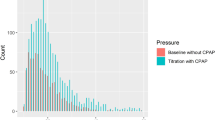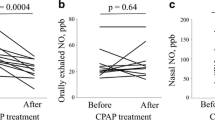Abstract
Introduction
This study examined both the relationship between the changes in the brain tissue hemoglobin indices and SpO2 during sleep in patients with obstructive sleep apnea syndrome (OSAS) and the effect of nasal continuous positive airway pressure (CPAP) treatment on hemoglobin indices.
Materials and methods
Polysomnographic recordings and near-infrared spectroscopy (NIRS) were performed during an afternoon nap on 15 OSAS patients before treatment and 12 healthy controls. Oxyhemoglobin (HbO), deoxyhemoglobin (HbD), and total hemoglobin (HbT) on NIRS were analyzed, and the correlation of these variables and peripheral arterial oxygen saturation (SpO2) were investigated in the OSAS group before nasal CPAP treatment. In nine OSAS patients, the recordings were also compared between the condition with and without using CPAP.
Results
HbO decreased during obstructive respiratory events while HbT and HbD showed adverse increases, and the values of these hemoglobin indices returned to the baseline values at the end of each respiratory event in the OSAS group. The fluctuations in these cerebral hemoglobin indices during sleep were significantly larger in the OSAS group than in the control group. Moreover, in the OSAS group, these changes correlated strongly with the change in SpO2. When using CPAP, not only respiratory events but also the fluctuations in both the cerebral hemoglobin indices and SpO2 were almost completely suppressed.
Conclusion
Arterial oxygen desaturation is clearly related to cerebral oxygenation, and fluctuations of hemoglobin indices can be suppressed with CPAP.


Similar content being viewed by others
References
Marin JM, Carrizo S, Vicente E, Agusti A (2005) Long term cardiovascular outcomes in men with obstructive sleep apnea with or without treatment with continuous positive airway pressure: an observational study. Lancet 365:1046–1053
Yaggi HK, Concato J, Kernan WN, Lichtman JH, Brass LM, Mohsenin VH (2005) Obstructive sleep apnea as a risk factor for stroke and death. New Engl J Med 353:2034–2041
Shamsuzzaman ASM, Gersh BJ, Somers VK (2003) Obstructive sleep apnea: implications for cardiac and vascular disease. JAMA 290:1906–1914
Cope M, Delpy DT, Reynolds EO, Wray S, Wyatt J, van der Zee P (1988) Methods of quantitating cerebral near infrared spectroscopy data. Adv Exp Med Biol 222:183–189
Jobsis FF (1977) Noninvasive infrared monitoring of cerebral and myocardial oxygen sufficiency and circulatory parameters. Science 198:1264–1267
Hayakawa T, Terashima M, Kayukawa Y, Ohta T, Okada T (1996) Changes in cerebral oxygenation and hemodynamics during obstructive sleep apneas. Chest 109:916–921
Hausser-Hauw C, Rakotonanahary D, Fleury B (2000) Obstructive-sleep apnea syndrome: brain oxygenation measured with near-infrared spectroscopy. Preliminary results. Neurophysiol Clin 30:113–118
Olopade CO, Mensah E, Gupta R, Huo D, Picchietti DL, Gratton E, Michalos A (2007) Noninvasive determination of brain tissue oxygenation during sleep in obstructive sleep apnea: a near-infrared spectroscopy approach. Sleep 30:1747–1755
Pizza F, Diplling MB, Wolf M, Werth E, Bassetti CL (2010) Nocturnal cerebral hemodynamics in snorers and patients with obstructive sleep apnea: a near infrared spectroscopy study. Sleep 33:205–210
Sullivan CE, Berthon-Jones M, Issa FG, Eves L (1981) Reversal of obstructive sleep apnea by continuous positive airway pressure applied through the nares. Lancet 317:862–865
Rechtschaffen A, Kales A (1968) A manual of standardized terminology, technique and scoring system for sleep stages of human subjects. Brain Information Service/Brain Research Institute, UCLA, Los Angeles
Task Force of the American Sleep Disorders Association (1992) EEG arousal: scoring rules and examples: a preliminary report from the Sleep Disorders Atlas. Sleep 15:173–184
Report of an American Academy of Sleep Medicine Task Force (1999) Sleep-related breathing disorders in adults: recommendations for syndrome definition and measurement techniques in clinical research. Sleep 22:667–689
Bar A, Pillar G, Dvir I, Cheffy J, Cchnall RP, Lavie P (2003) Evaluation of a portable device based on peripheral arterial tone for unattended home sleep studies. Chest 123:695–703
Hoshi Y, Mizukami S, Tamura M (1994) Dynamic features of hemodynamic and metabolic changes in the human brain during all-night sleep as revealed by near-infrared spectroscopy. Brain Res 652:257–262
American Thoracic Society (1994) Indications and standards for use of nasal continuous positive airway pressure (CPAP) in sleep apnea syndromes. Am J Respir Crit Care Med 150:1738–1745
Elwell CE (1995) A practical user’s guide to near infrared spectroscopy. Hamamatsuo Photonics KK, London, pp 1–155
Hajak G, Klingelhöfer J, Schulz-Varszegi M, Ruther E, Klingelhofer J, Sander D (1996) Sleep apnea syndrome and cerebral hemodynamics. Chest 110:670–679
Siebler M, Nachtmann A (1993) Cerebral hemodynamics in obstructive sleep apnea. Chest 103:1118–1119
Netzer N, Werner P, Jochums I, Lehmann M, Strohl KP (1988) Blood flow of middle cerebral artery with sleep-disordered breathing. Correction with obstructive hypopneas. Stroke 29:87–93
Spielman AJ, Zhang G, Yang C-M, D’Ambrosio P, Serizawa S, Nagata M, von Gizychi H, Alfano RR (2000) Intracerebral hemodynamics probed by near infrared spectroscopy in the transition between wakefulness and sleep. Brain Res 866:313–325
Ficker JM, Feistel H, Möller C, Merkl M, Dertinger S, Siegfried W, Hahn EG (1997) Veränderungen der regionalen ZNS-perfusion beim obstruktiven schlafapnoe-syndrom: erste SPECT-untersuchungen mit nächtlich injiziertem 99mTc-HMPAO. Pneumologie 51:926–930
Bålfors EM, Franklin KA (1994) Impairment of cerebral perfusion during obstructive sleep apneas. Am J Respir Crit Care Med 150:1587–1591
Diomedi M, Placidi F, Cupini LM, Bernardi G, Silvestrini M (1998) Cerebral hemodynamic changes in sleep apnea syndrome and effect of continuous positive airway pressure treatment. Neurology 51:1051–1056
Foster GE, Hanly PJ, Ostrowski M, Poulin MJ (2007) Effects of continuous positive airway pressure on cerebral vascular response to hypoxia in patients with obstructive sleep apnea. Am J Respir Crit Care Med 175:720–725
Bassetti C, Aldrich M (1999) Sleep apnea in acute cerebrovascular diseases: final report on 128 patients. Sleep 22:217–223
Partinen M, Palomäki H (1985) Snoring and cerebral infarction. Lancet 326:1325–1326
Hiroki M, Uema T (2005) Cerebral white matter blood flow is constant during human non-rapid eye movement sleep: a positron emission tomography study. J Appl Physiol 98:1846–1854
Ehlis AC, Herrmann MJ, Plichta MM, Fallgatter AJ (2007) Control activation during two verbal fluency task in schizophrenic patients and healthy controls as assessed by multi-channel near-infrared spectroscopy. Psychiatry Res 156:1–13
Acknowledgment
The authors are indebted to Prof. J. Patrick Barron of the Department of International Medical Communications of Tokyo Medical University for his review of this manuscript.
Author information
Authors and Affiliations
Corresponding authors
Additional information
Yuichi Inoue and Akira Matsuo contributed equally to this case report.
Rights and permissions
About this article
Cite this article
Matsuo, A., Inoue, Y., Namba, K. et al. Changes in cerebral hemoglobin indices in obstructive sleep apnea syndrome with nasal continuous positive airway pressure treatment. Sleep Breath 15, 487–492 (2011). https://doi.org/10.1007/s11325-010-0367-y
Received:
Revised:
Accepted:
Published:
Issue Date:
DOI: https://doi.org/10.1007/s11325-010-0367-y




